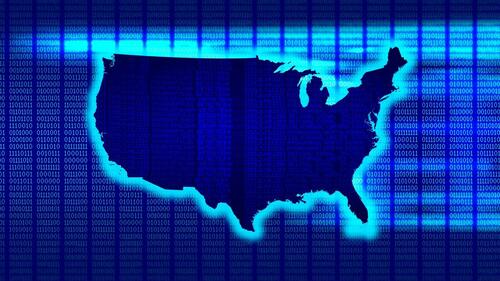Authored by Julio Rivera via American Greatness,
Artificial intelligence (AI) and its integration within various sectors is moving at a speed that couldn’t have been imagined just a few years ago. As a result, the United States now stands on the brink of a new era of cybersecurity challenges. With AI technologies becoming increasingly sophisticated, the potential for their exploitation by malicious actors grows exponentially.
Because of this evolving threat, government agencies like the Department of Homeland Security (DHS) and the Cybersecurity and Infrastructure Security Agency (CISA), alongside private sector entities, must urgently work to harden America’s defenses to account for any soft spots that may be exploited. Failure to do so could have dire consequences on a multitude of levels, especially as we approach the upcoming U.S. presidential election, which is likely to be the first to contend with the profound implications of AI-driven cyber warfare.
AI’s transformative potential is undeniable, revolutionizing industries from healthcare to finance. However, this same potential poses a significant threat when harnessed by cybercriminals. According to a report by the UK’s Government Communications Headquarters (GCHQ), the rise of AI is expected to lead to a marked increase in cyberattacks in the coming years. AI can automate and enhance the scale, speed, and sophistication of these attacks, making them more difficult to detect and counteract.
The nature of AI-driven cyber threats is multifaceted. AI can be used to create highly convincing phishing attacks, automate vulnerability discovery by foreign adversaries in software systems to identify backdoors, and launch large-scale Distributed Denial of Service (DDoS) attacks.
Moreover, AI algorithms can be employed to develop malware or trojans that adapt and evolve to evade detection. The GCHQ report warns of the growing use of AI by cyber adversaries to improve the effectiveness of their attacks, posing a significant challenge for traditional cybersecurity protocols.
The stakes are particularly high as the United States prepares for the November election. DHS has already issued warnings about the threats posed by AI to the election process. Among the potential threats posed by AI are deepfakes, automated disinformation campaigns, and targeted social engineering attacks. These tactics could undermine the integrity of the election, erode public trust in democratic institutions, and sow discord among the electorate.
The potential for disruptions in trust and accuracy in the election process is not exactly an unprecedented threat. In the 2020 election, there were already instances of misinformation and foreign interference. With AI’s capabilities advancing rapidly, the 2024 election could see these efforts become more sophisticated and harder to counter.
It seems that every day, more and more AI-generated deepfakes are being disseminated on social media. Many of these are intended to be humorous, or they are being used in digital marketing campaigns to sell products, but in an election scenario, disrupters could create realistic but fake videos of candidates, potentially influencing voter perceptions and decisions.
One of the most significant challenges in addressing AI-driven cyber threats is the pervasive underestimation of their potential impact. Many in both the public and private sectors fail to grasp the severity and immediacy of these threats. This complacency is partly due to the abstract nature of AI and a lack of understanding of how it can be weaponized. However, as AI continues to integrate into critical infrastructure and various sectors of the economy, the risks become more tangible and immediate.
In response to funding proposals from the National Security Commission on Artificial Intelligence, a bipartisan group of senators just unveiled a $32 billion spending proposal. This investment is not merely in developing AI for civilian or commercial use but explicitly in enhancing offensive cyber capabilities. The potential for AI to augment cyberwarfare necessitates a reevaluation of our current cybersecurity strategies.
Addressing the AI-driven cyber threat landscape requires a concerted effort from both government agencies and the private sector. Government agencies like DHS and CISA must update and expand existing cybersecurity frameworks to address AI-specific threats. This includes developing guidelines for detecting and mitigating AI-driven malware attacks and ensuring that these guidelines are disseminated across all levels of government and critical infrastructure sectors.
Beyond the scope of just the public sector, we must realize that effective cybersecurity is a collaborative effort. The government must foster stronger partnerships with the private sector, leveraging the expertise and resources of technology companies, cybersecurity firms, and other stakeholders. These kinds of joint initiatives and information-sharing platforms can help in the rapid identification and response to AI-driven threats. CISA has previously attempted to strengthen these relationships, but much more must be done.
Additionally, raising public awareness about the risks posed by AI-driven cyber threats is essential. Educational campaigns can help individuals recognize and respond to phishing attempts, data collection efforts, disinformation, and other cyber threats, while fostering a culture of cybersecurity awareness in organizations can reduce the risk of successful attacks.
Lastly, policymakers must consider new regulations and legislative measures to address the unique challenges posed by AI in cybersecurity. This includes updating cybersecurity laws to incorporate AI-specific considerations and ensuring that regulatory frameworks keep pace with technological advancements.
America, as a nation, stands on the precipice of an increasingly AI-driven future. The potential for AI-based cyber attacks represents one of the most pressing security challenges of our time, and November’s election underscores the urgency of addressing these threats as the integrity of our democratic process hangs in the balance.
The time for complacency has passed. The United States must act decisively to protect its digital infrastructure and democratic institutions from the evolving threats posed by AI-driven cyber attacks. Our national security, economic and global stability, and the very fabric of our democracy depend on it.
